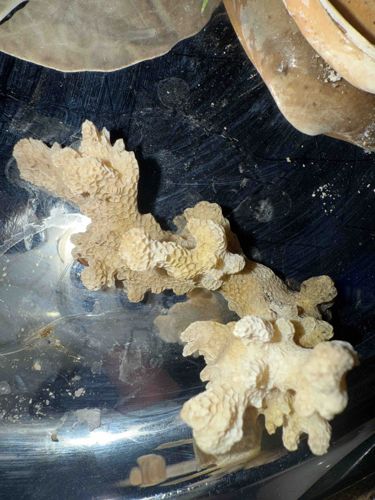
Fungus (Possibly Schizophyllum commune or similar bracket fungus)
The item appears to be a dried specimen of a fungus, specifically resembling a bracket fungus or shelf fungus due to its irregular, somewhat fan-like or shelf-like formations. The overall color is a light, bone-like beige or off-white, suggesting it has either dried out naturally or been preserved. Its surface is highly textured and convoluted, exhibiting numerous small, intricate folds, ridges, and pores, which are characteristic of the hymenophore (spore-bearing surface) of some fungi. The edges of the structure are uneven and somewhat friable, with small projections and indentations. The fungus seems to grow in a branching or cluster-like manner, with multiple lobes or segments originating from a central or basal attachment point, though the full extent of this attachment is not visible. There are no overt signs of decay or active growth, indicating it is likely a desiccated specimen. Visible condition issues include some general dust accumulation, as well as several spots and streaks of what appear to be dirt or debris on its surface, particularly in the crevices. Its natural, organic form makes it difficult to ascertain precise dimensions, but it appears to be a smaller specimen, perhaps several inches across at its widest points. There are no discernible manufacturing marks, signatures, or stamps, as it is a natural biological specimen. It strongly resembles species such as Schizophyllum commune, known for its split gills and leathery texture when dry. Its aesthetic suggests it could be used for decorative purposes or as a botanical specimen.
AI-Generated Appraisal Disclaimer
Estimated Value
$5 - $15
Basic Information
Category
Natural Specimen
Appraised On
November 27, 2025
Estimated Value
$5 - $15
Item Description
The item appears to be a dried specimen of a fungus, specifically resembling a bracket fungus or shelf fungus due to its irregular, somewhat fan-like or shelf-like formations. The overall color is a light, bone-like beige or off-white, suggesting it has either dried out naturally or been preserved. Its surface is highly textured and convoluted, exhibiting numerous small, intricate folds, ridges, and pores, which are characteristic of the hymenophore (spore-bearing surface) of some fungi. The edges of the structure are uneven and somewhat friable, with small projections and indentations. The fungus seems to grow in a branching or cluster-like manner, with multiple lobes or segments originating from a central or basal attachment point, though the full extent of this attachment is not visible. There are no overt signs of decay or active growth, indicating it is likely a desiccated specimen. Visible condition issues include some general dust accumulation, as well as several spots and streaks of what appear to be dirt or debris on its surface, particularly in the crevices. Its natural, organic form makes it difficult to ascertain precise dimensions, but it appears to be a smaller specimen, perhaps several inches across at its widest points. There are no discernible manufacturing marks, signatures, or stamps, as it is a natural biological specimen. It strongly resembles species such as Schizophyllum commune, known for its split gills and leathery texture when dry. Its aesthetic suggests it could be used for decorative purposes or as a botanical specimen.
Related Tags
Explore similar items and categories:
Get Your Items Appraised
Instant estimates of your treasures with AI-powered instant appraisals